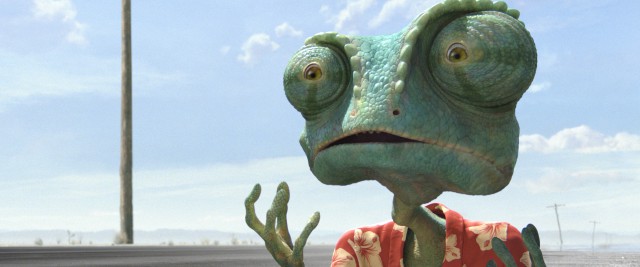
“Animation isn’t a genre” like Westerns, film noir,
romance or horror, Gore Verbinski was saying. “It’s just a technique
for telling a story.”
So when the man behind the hugely popular “Pirates
of the Caribbean” series decided to make his first animated feature,
his biggest concern wasn’t about the process of animation but about the
process of storytelling.
Verbinski, 46, could have stuck with the “Pirates”
franchise, which has made him a very rich man. But he decided not to
get involved with the fourth installment, which sails into megaplexes
on
“Three ‘Pirates’ was enough,” the director said in a recent phone conversation from
The result of that outlook is “Rango,” the computer-animated feature opening Friday.
wasteland and ends up defending a town of desert rats (literally rats
… and rabbits, groundhogs, mice and other critters) against the
depredations of a water-hoarding tyrant.
It’s a spoof of classic Westerns that turns the genre on its head while maintaining an atmosphere of total spontaneity.
“That was our biggest fear, that we couldn’t keep it
fresh,” Verbinski said. “Our mantra throughout every aspect of
production was to pursue the awkward moment, celebrate the flaw, do
anything to prevent the presentation from becoming clinical or
homogeneous.
“The problem with animation is that everything has
to be planned before you can complete a frame of film. In those
circumstances you start to lose what would have been intuitive. You
have to fabricate everything because nothing really exists. But can you
fabricate the feeling that it’s happening for the first time while we
watch?”
Phase 1 of “Rango” began with Verbinski and several writers holing up in a house in the hills above
“We were there for 16 months with pencils, papers,
guitars, a Macintosh computer. We created a 12-page outline with the
basic bones of the journey. Then we fleshed it out, threw out some
trash, fleshed it out some more. We drew stick figures, then moved on
to detailed characters.”
Phase 2 found Verbinski and all of his voice actors — among them Depp,
Nothing like it had ever been done before. Typically
animation voice actors record their lines in solitude, rarely
interacting with the other actors with whom they share scenes.
This was more like a rehearsal for a play.
“We created some chaos to see what would come out of
it,” Verbinski recalled. “We had several goals. First, to replace our
awful dialogue with new lines generated in actual performance. And
second, to be aware of any gifts that might present themselves.
“I mean, this was an unbelievable cast. I was lucky to get virtually every first choice on my list.”
The actors didn’t just read dialogue. They acted out
the scenes while cameras recorded their performances. If a scene was to
be set in a 20-by-20-footroom, the actors had to work within an area
precisely the same size taped out on the floor. A couple of sawhorses
and a few boards served as a saloon bar to lean against.
“If a character had to walk, the actor had to walk,” Verbinski said.
Animators used the videotapes of those performances
as inspiration . But Verbinski stresses that at no time in the
production did he rely on motion capture. That’s the system used for
aliens in “Avatar” and Gollum in “The Lord of the Rings,” where sensors
attached to an actor’s body record movements into a computer.
“There was zero motion capture. We were basically
trying to get the audio track where it felt it was as honest as it
could be. We were shooting video mostly as a performance reference.”
Phase 3 of “Rango” was a challenge as well.
Verbinski had associates and friends at Industrial Light & Magic
who had provided the many special effects for the “Pirates” films. But
this time the ILM folk weren’t asked to simply add f/x to an existing
film. They were animating an entire movie from scratch.
“I had to get them to stop thinking in terms of just
one shot and start thinking in terms of entire scenes,” Verbinski said.
“With a ‘Pirate’ film I’d come to them with everything on a plate and
every intention spelled out. The actors’ performances were finished
before the ILM people went to work.
“But for ‘Rango’ they had to be true animators. They
were discussing character. They had arguments over why Rango was
blinking in frame 36 instead of frame 46. These were decisions they’d
never faced before.”
“Rango” pushed Verbinski’s hand-picked ILM crew members to do their most artistically creative work to date.
“There was a comfort level in terms of knowing what
we could achieve. We knew we could pull it off. But there was also a
tremendous energy from not always knowing what we were doing.
“Nobody on this film had made an animated movie before. We just threw out the rule book.”
The whole process, he said, was a bit scary but very liberating.
“When things don’t scare you anymore it’s time to find something you’re not sure you can do.”
———
FILMOGRAPHY: MORE ABOUT GORE
Gore Verbinski’s three “Pirates of the Caribbean”
films — “Curse of the Black Pearl,” “Dead Man’s Chest” and “At World’s
End” — have earned
—”Mousehunt” (1997): This live-action cartoon featured
—”The Mexican” (2001): Battling lovers
—”The Ring” (2002): American remake of a Japanese
horror film about a videotape that kills several days after a victim
watches it. With
—”The Weather Man” (2005):
———
(c) 2011, The Kansas City Star.
Visit The Star Web edition on the World Wide Web at http://www.kansascity.com.
Distributed by McClatchy-Tribune Information Services.














